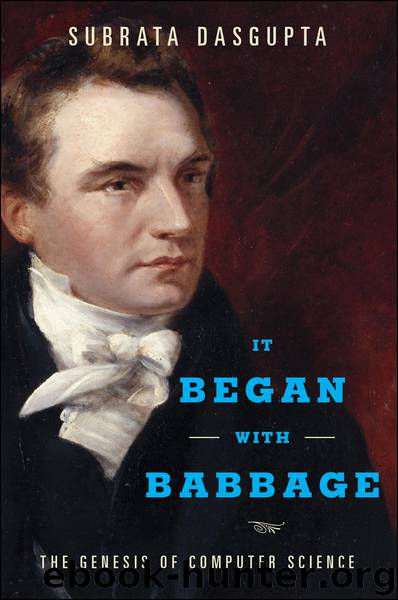It Began with Babbage by Dasgupta Subrata

Author:Dasgupta, Subrata
Language: eng
Format: epub, mobi, azw3
Publisher: Oxford University Press, USA
Published: 2014-03-24T16:00:00+00:00
VI
New scientific paradigms, new artistic and literary styles, and new technological movements are created by a select few. The birth of new creative impulses belong to the realm, primarily, of intellectual history rather than to social or cultural history. It is only when that impulse or movement is recognized as a paradigm that it spreads to the larger population. Revolutionary science, art, design then become normal science, art, design. Which is why we find the birthing years of computer science dominated by a small number of people, some of whom appear, disappear, and reappear during these early years. It is as if, having carved out a space of their own—indeed, created a space of their own—having been led to a virgin land they invent for themselves a space within that land before other newcomers have the chance to come on it. von Neumann was one such person, as we have seen. Turing was surely another (and he will appear once more very soon). Shannon was a third such person.
Shannon, as we have also seen, in 1938, connected the technological art of switching circuit design with the abstract, symbolic logic of Boolean algebra. It is, perhaps, for this reason that the design of circuits that input, process, and output the Boolean values—1 and 0 or TRUE and FALSE—is called logic design.44 In fact, during the late 1940s, Shannon did much more. In 1948, then a mathematician at the Bell Telephone Laboratories in Murray Hill, New Jersey, Shannon published an article on a mathematical theory of communication.45 A year later, with Warren Weaver (1894–1978), a mathematician and preeminent science administrator at the Rockefeller Foundation, Shannon published a book that developed this theory more fully.46
The mathematical theory of communication is otherwise and more succinctly called information theory, which forms the theoretical foundation of telecommunications engineering and has also influenced the study of human communication.47 The word information is used in information theory in a specific sort of way; it has nothing to do with how “information” is understood in everyday language. We usually think of information as being about something. In common parlance, information has meaning, there is a semantic aspect to it. In information theory, however, information is devoid of meaning. It is simply the commodity that is transmitted across communication “channels,” whether between human beings, along telegraph wires, or across telephone lines. The unit of information in information theory is called the bit (short for binary digit, a term coined by another distinguished Bell Laboratory mathematician and Shannon’s colleague, John W. Tukey [1915–2000]48). It means nothing but itself, just as a unit of money refers to nothing but itself.
Shannon is commonly referred to as the Father of Information Theory, but—like all such glib journalistic appellations—this, too, much be viewed quizzically if only because the history of the origins of information theory began well before Shannon.49 What is beyond dispute is that he has a preeminent place in the creation of information theory.
Insofar as the transmission and storage of information bits are
Download
It Began with Babbage by Dasgupta Subrata.mobi
It Began with Babbage by Dasgupta Subrata.azw3
This site does not store any files on its server. We only index and link to content provided by other sites. Please contact the content providers to delete copyright contents if any and email us, we'll remove relevant links or contents immediately.
Algorithms of the Intelligent Web by Haralambos Marmanis;Dmitry Babenko(16234)
Jquery UI in Action : Master the concepts Of Jquery UI: A Step By Step Approach by ANMOL GOYAL(9386)
Test-Driven Development with Java by Alan Mellor(7735)
Data Augmentation with Python by Duc Haba(7608)
Principles of Data Fabric by Sonia Mezzetta(7378)
Learn Blender Simulations the Right Way by Stephen Pearson(7294)
Microservices with Spring Boot 3 and Spring Cloud by Magnus Larsson(7137)
Hadoop in Practice by Alex Holmes(6587)
RPA Solution Architect's Handbook by Sachin Sahgal(6515)
The Infinite Retina by Robert Scoble Irena Cronin(6216)
Big Data Analysis with Python by Ivan Marin(5933)
Life 3.0: Being Human in the Age of Artificial Intelligence by Tegmark Max(5514)
Pretrain Vision and Large Language Models in Python by Emily Webber(4894)
Infrastructure as Code for Beginners by Russ McKendrick(4653)
Functional Programming in JavaScript by Mantyla Dan(4436)
WordPress Plugin Development Cookbook by Yannick Lefebvre(4382)
The Age of Surveillance Capitalism by Shoshana Zuboff(4245)
Embracing Microservices Design by Ovais Mehboob Ahmed Khan Nabil Siddiqui and Timothy Oleson(4148)
Applied Machine Learning for Healthcare and Life Sciences Using AWS by Ujjwal Ratan(4135)
